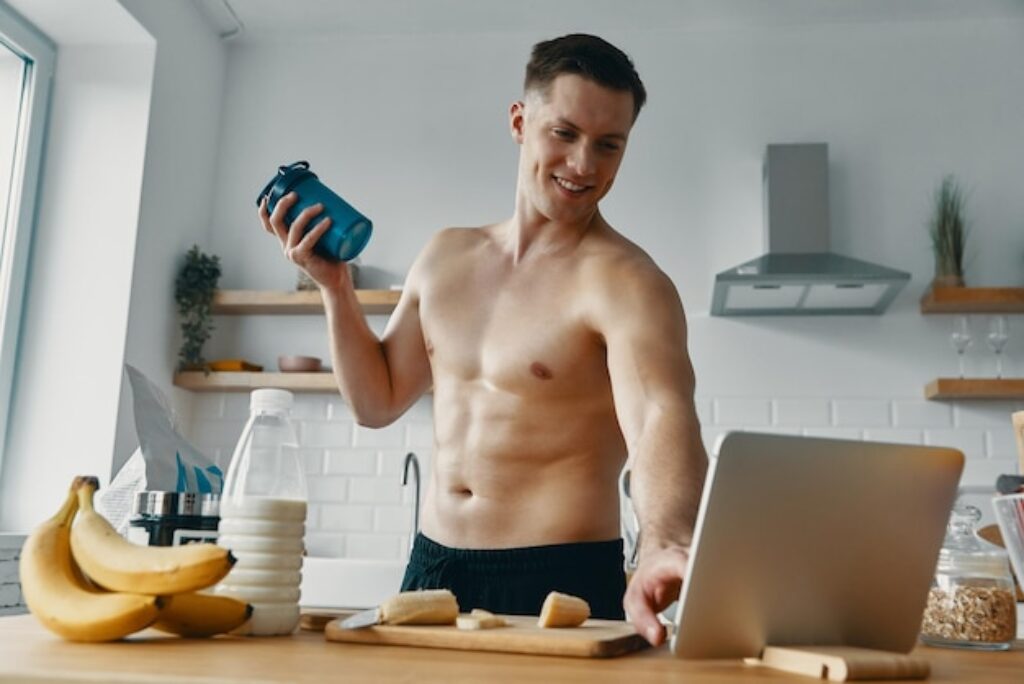Introduction: Building Muscle After 40
As we age, our bodies undergo a myriad of changes, some more apparent than others. Is it hard building muscle after 40 or not? Significant stats state that many men face after hitting the milestone of 40 is the gradual loss of muscle mass and strength. However, contrary to popular belief, building muscle after 40 is not only possible but also incredibly beneficial for maintaining overall health and vitality.
In this comprehensive guide, we will embark on a journey to unlock the secrets of maximizing your strength and building lean muscle mass, even after the age of 40. Together, we will explore the science behind age-related changes, the importance of strength training, and the essential components of an effective muscle-building regimen tailored specifically for the unique needs of older adults.
Understanding the Challenges: Age-related Changes in Muscle Mass
Before we delve into the strategies for building muscle after 40, it is crucial to understand the physiological changes that occur as we age. One of the most significant challenges we face is a phenomenon known as sarcopenia, which is the gradual loss of skeletal muscle mass and strength.
This process begins around the age of 30 and accelerates after 40, leading to a reduction in muscle mass of approximately 3-8% per decade. Additionally, hormonal changes, such as a decrease in testosterone levels in men and estrogen levels in women, can contribute to the loss of muscle mass and strength.
However, it is important to note that these age-related changes are not inevitable. By adopting a proactive approach and incorporating targeted strategies, we can mitigate the effects of sarcopenia and maintain, or even build, lean muscle mass after 40.

The Importance of Strength Training for Older Adults
Strength training is not just for bodybuilders or athletes; it is an essential component of a healthy lifestyle for individuals of all ages, especially those over 40. Regular strength training offers numerous benefits, including:
- Increased Muscle Mass and Strength: Resistance exercises stimulate muscle growth and help combat the age-related loss of muscle mass and strength.
- Improved Bone Density: Weight-bearing exercises help maintain and improve bone density, reducing the risk of osteoporosis and fractures.
- Enhanced Metabolic Rate: Muscle is metabolically active tissue, meaning that the more muscle you have, the higher your resting metabolic rate, which can aid in weight management.
- Better Balance and Coordination: Strength training improves balance, coordination, and overall functional ability, reducing the risk of falls and injuries.
- Improved Quality of Life: Increased strength and mobility can enhance independence and make daily activities easier, contributing to a better quality of life.
By incorporating strength training into your routine, you can not only build muscle but also reap a multitude of benefits that can significantly improve your overall health and well-being.
Nutrition and Muscle Building After 40
While exercise is a crucial component of building muscle after 40, proper nutrition plays an equally important role. As we age, our bodies may have different nutritional requirements, and adjusting our diet accordingly can support our muscle-building efforts.
- Protein Intake: Adequate protein intake is essential for muscle growth and repair. Aim for a daily protein intake of 0.5-0.8 grams per pound of body weight, distributed evenly throughout the day. Good sources of protein include lean meats, fish, eggs, dairy, and plant-based options like legumes and soy.
- Calorie Surplus: To build muscle, you need to consume more calories than you burn. A slight calorie surplus of 300-500 calories above your maintenance level can support muscle growth while minimizing excessive fat gain.
- Nutrient-Dense Foods: Focus on nutrient-dense whole foods that provide essential vitamins, minerals, and antioxidants. These nutrients support muscle recovery, immune function, and overall health.
- Hydration: Staying properly hydrated is crucial for muscle function, recovery, and overall health. Aim to drink at least eight glasses of water per day, and adjust your intake based on your activity levels and climate.
Remember, proper nutrition is not a one-size-fits-all approach. It may be beneficial to consult with a registered dietitian or nutritionist to develop a personalized plan that meets your specific needs and goals.
“Age is just a number. Strength knows no bounds. Building muscle after 40 is not just possible; it’s a testament to resilience, determination, and the power of the human spirit.”
Tailoring Your Workout Routine: Choosing the Right Exercises
When it comes to building muscle after 40, not all exercises are created equal. It is essential to tailor your workout routine to target the specific muscle groups you want to develop while considering any potential limitations or injuries.
- Compound Exercises: Focus on compound exercises that engage multiple muscle groups simultaneously. Examples include squats, deadlifts, push-ups, and pull-ups. These exercises are efficient and effective for building overall strength and muscle mass.
- Isolation Exercises: Incorporate isolation exercises to target specific muscle groups that may need extra attention. Examples include bicep curls, tricep extensions, and calf raises.
- Functional Movements: Include functional movements that mimic everyday activities, such as lunges, step-ups, and overhead presses. These exercises improve strength, balance, and coordination, which are essential for maintaining independence and reducing the risk of falls.
- Low-Impact Options: If you have joint issues or limitations, consider low-impact exercises like resistance bands, bodyweight exercises, or water-based workouts. These options can still provide an effective muscle-building stimulus while minimizing stress on your joints.
Remember, it is crucial to start with a weight or resistance level that challenges you without compromising proper form. Gradually increase the intensity and volume as you become stronger and more conditioned.
Training Techniques for Building Muscle After 40
In addition to choosing the right exercises, incorporating specific training techniques can optimize your muscle-building efforts after 40. Here are some effective strategies to consider:
- Progressive Overload: Consistently challenging your muscles by gradually increasing the weight, reps, or intensity is essential for continued muscle growth. This principle, known as progressive overload, signals your body to adapt and build more muscle.
- Varied Resistance: Incorporate a variety of resistance types, such as free weights, resistance bands, bodyweight exercises, and machines. This variety can help target muscles from different angles and prevent plateaus.
- Tempo Training: Manipulating the speed at which you perform each exercise can create additional muscle tension and stimulate growth. Slower eccentric (lowering) movements and paused repetitions can be particularly effective.
- Split Routines: Instead of working your entire body in a single session, consider splitting your routine into upper and lower body days or targeting specific muscle groups on different days. This approach allows for adequate recovery between sessions and can promote better muscle growth.
- Rest-Pause Training: This technique involves performing a set to momentary muscular failure, resting for a brief period (10-30 seconds), and then completing additional reps until failure. This method can help you push past plateaus and stimulate further muscle growth.
Remember, consistency and proper form are essential when implementing these training techniques. It is also crucial to listen to your body and adjust your routine as needed to avoid overtraining or injury.

Recovery and Rest: Essential Components for Muscle Growth
While training is crucial for building muscle after 40, recovery and rest are equally important components of the muscle-building process. Adequate rest and recovery allow your muscles to repair and grow, preventing overtraining and reducing the risk of injury.
- Sleep: Aim for 7-9 hours of quality sleep each night. During sleep, your body releases growth hormones and other essential hormones that support muscle recovery and growth.
- Active Recovery: Incorporate active recovery days into your routine, where you engage in low-intensity activities like walking, stretching, or light cardio. These activities promote blood flow and can aid in muscle recovery without overexerting your body.
- Massage and Foam Rolling: Techniques like massage and foam rolling can help alleviate muscle soreness, improve mobility, and promote recovery by increasing blood flow and reducing muscle tension.
- Stress Management: Chronic stress can impede muscle growth and recovery by disrupting hormone levels and inhibiting the body’s ability to repair and rebuild muscle tissue. Engage in stress-reducing activities like meditation, yoga, or deep breathing exercises.
- Deload Weeks: Periodically incorporate deload weeks into your training program, where you significantly reduce the volume and intensity of your workouts. These deload periods allow your body to fully recover and can prevent overtraining and plateaus.
Remember, recovery and rest are not periods of inactivity; they are essential components of a successful muscle-building program. By prioritizing recovery, you can optimize your body’s ability to adapt and grow stronger.
Overcoming Plateaus and Staying Motivated
Building muscle after 40 is a journey that may present challenges and plateaus along the way. It is essential to have strategies in place to overcome these obstacles and maintain motivation throughout the process.
- Tracking Progress: Regularly track your progress by monitoring metrics such as body measurements, strength gains, and progress photos. Seeing tangible results can provide motivation and help you identify areas that may need adjustment.
- Varying Your Routine: If you find yourself plateauing, consider varying your routine by changing the exercises, rep ranges, or training techniques. This variation can provide a new stimulus for your muscles and help break through stagnation.
- Setting Achievable Goals: Set realistic and achievable goals for yourself, both short-term and long-term. Celebrate each milestone along the way, as these small victories can fuel your motivation and keep you focused on your ultimate objective.
- Finding Accountability: Consider enlisting the support of a training partner, coach, or online community. Having accountability and a support system can provide encouragement, motivation, and guidance when needed.
- Embracing the Journey: Building muscle after 40 is a journey, not a destination. Embrace the process, celebrate your progress, and enjoy the newfound strength and vitality that comes with each step forward.
Remember, overcoming plateaus and maintaining motivation requires a combination of patience, perseverance, and a willingness to adapt and evolve your approach as needed.

Common Mistakes to Avoid When Building Muscle After 40
While building muscle after 40 is achievable, there are certain mistakes that can hinder your progress or even lead to injury. Being aware of these common pitfalls can help you navigate your muscle-building journey more effectively.
- Neglecting Proper Form: Sacrificing proper form for heavier weights or more reps can increase your risk of injury and limit the effectiveness of your exercises. Always prioritize proper form and technique over weight or intensity.
- Overtraining: Pushing your body beyond its limits can lead to overtraining, which can impede muscle growth and recovery. Listen to your body and allow for adequate rest and recovery between intense workout sessions.
- Neglecting Mobility and Flexibility: As we age, our mobility and flexibility can decrease, which can impact our ability to perform exercises correctly and increase the risk of injury. Incorporate mobility and flexibility work into your routine to maintain proper joint function and range of motion.
- Inconsistent Nutrition: Failing to provide your body with the necessary nutrients and caloric intake can sabotage your muscle-building efforts. Consistently follow a balanced and nutrient-dense diet tailored to your specific needs and goals.
- Lack of Patience: Building muscle is a gradual process that requires patience and consistency. Expecting rapid results can lead to frustration and potentially unsafe or unsustainable practices. Embrace the journey and trust the process.
By being aware of these common mistakes and taking proactive steps to avoid them, you can optimize your muscle-building efforts and minimize the risk of setbacks or injuries.
Supplements for Building Muscle After 40
While a balanced diet should be the primary source of nutrients for building muscle, certain supplements can provide additional support and aid in the muscle-building process after 40. However, it is important to consult with a healthcare professional before incorporating any new supplements into your routine.
- Protein Supplements: Protein supplements, such as whey, casein, or plant-based options, can help ensure adequate protein intake, especially on days when it may be challenging to meet your protein needs through whole foods alone.
- Creatine: Creatine is a naturally occurring compound that can help increase muscle strength, power, and size. It is one of the most well-researched and effective supplements for building muscle.
- Branched-Chain Amino Acids (BCAAs): BCAAs, including leucine, isoleucine, and valine, are essential for muscle protein synthesis and can aid in muscle recovery and growth.
- Omega-3 Fatty Acids: Omega-3 fatty acids, found in fish oil or plant-based sources like flaxseed or chia seeds, can help reduce inflammation and support overall health and recovery.
- Vitamin D: Vitamin D plays a crucial role in muscle function and strength. As we age, our ability to synthesize vitamin D from sunlight decreases, making supplementation potentially beneficial.
- Multivitamin: A high-quality multivitamin can help fill any potential nutrient gaps in your diet and support overall health and muscle recovery.
Remember, supplements should never replace a balanced and nutrient-dense diet. Always consult with a healthcare professional before incorporating any new supplements into your routine, as they may interact with medications or have potential side effects.
Celebrating Success: Inspiring Stories of Older Adults Who Have Built Muscle
Building muscle after 40 is not only possible but also a reality for many individuals who have embraced the challenge and achieved remarkable results. Here are a few inspiring stories of older adults who have defied the odds and built impressive muscle mass:
- Ernestine Shepherd: At 86 years old, Ernestine Shepherd holds the Guinness World Record for the oldest female bodybuilder. She began her fitness journey in her 50s and has since become an inspiration to many, showcasing the power of determination and dedication.
- Sam Bryant Jr.: At 73 years old, Sam Bryant Jr. is a competitive bodybuilder and personal trainer. He began his journey in his 60s and has since won numerous competitions, proving that age is just a number when it comes to building muscle.
- Janice Eng: Janice Eng, a 65-year-old powerlifter, has set multiple world records in her age and weight class. Her incredible strength and dedication serve as a reminder that building muscle is not limited by age or gender.
- Bill Pearl: Bill Pearl, a former Mr. Universe, continued to train and maintain an impressive physique well into his 80s. His commitment to fitness and muscle-building serves as an inspiration for individuals of all ages.
These remarkable individuals serve as living proof that building muscle after 40 is not only possible but can also lead to a newfound sense of confidence, strength, and vitality. Their stories serve as a reminder that with dedication, perseverance, and the right approach, age is merely a number, and the pursuit of building muscle knows no bounds.
Conclusion: Embracing the Journey of Building Muscle After 40
Building muscle after 40 is a journey that requires commitment, patience, and a willingness to adapt and evolve your approach. By understanding the challenges, embracing proper nutrition and training techniques, prioritizing recovery, and avoiding common mistakes, you can unlock your potential and achieve remarkable results.
Remember, the road to building muscle is not a linear path, and setbacks or plateaus are natural occurrences. Embrace these challenges as opportunities for growth and remain steadfast in your pursuit of strength and vitality.
As you embark on this journey, celebrate each milestone, draw inspiration from the success stories of others, and never lose sight of the profound benefits that building muscle can have on your overall health, confidence, and quality of life.If you’re ready to transform your body and embrace a newfound sense of strength and vitality, consider working with a certified personal trainer or strength coach who specializes in training older adults. Their expertise can help you navigate the unique challenges of building muscle after 40 and develop a personalized plan tailored to your specific needs and goals. Don’t let age be a barrier – take the first step towards maximizing your strength and unlocking your full potential today.
Building muscle after 40 is not just a physical pursuit; it is a testament to the resilience and adaptability of the human body and spirit. Embrace this journey with open arms, and let it be a source of empowerment, inspiration, and a celebration of your commitment to living a life of strength, vitality, and personal growth.
Decoding Fitness: Exposing the Top 10 Fitness Myths
The Science Behind Muscle Recovery: Effective Strategies for Post-Workout Healing

Mastering the Basics: A Comprehensive Guide to Muscle Building for Beginners





